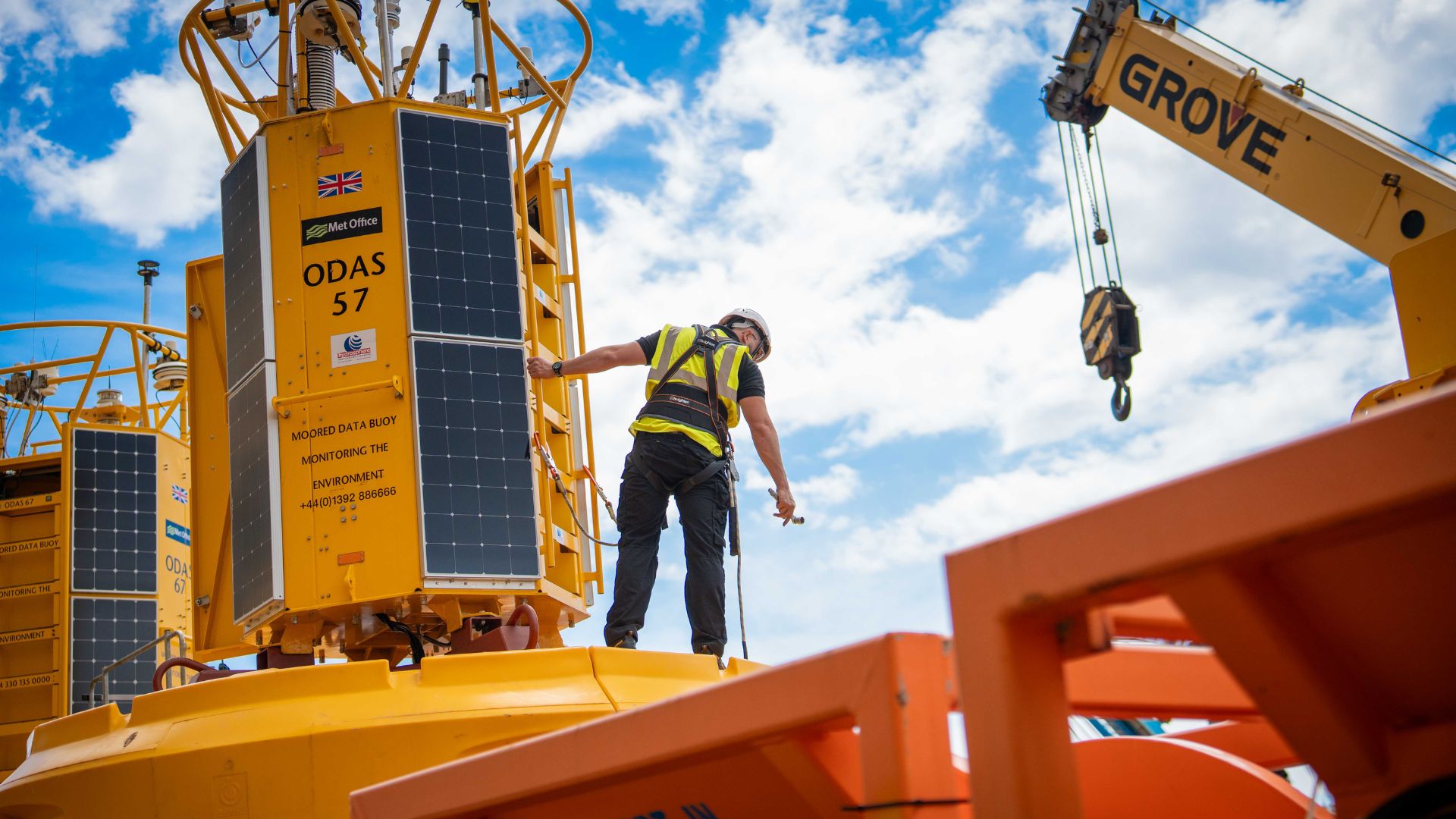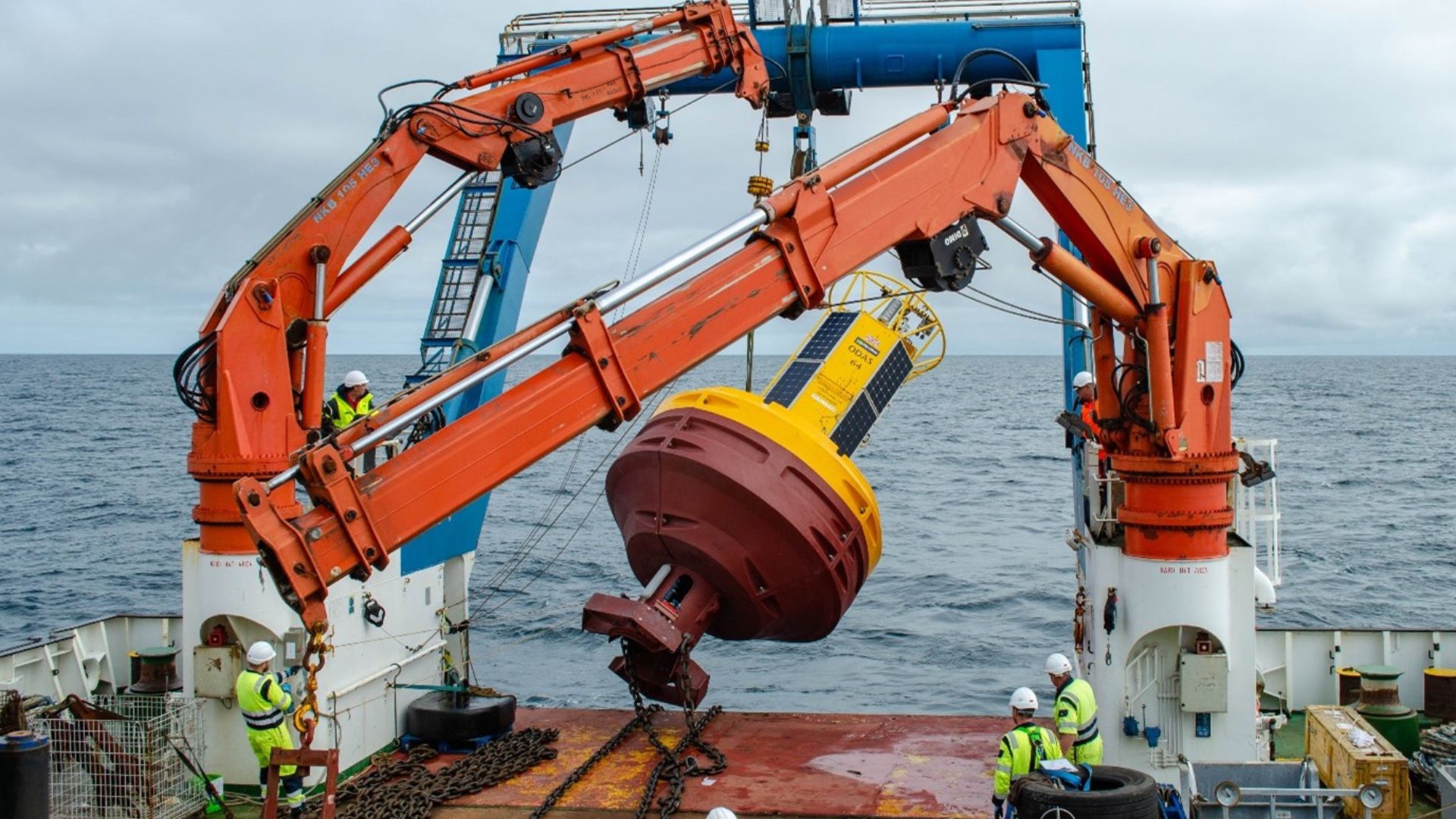In the remote waters of the North Atlantic, one of our ocean buoys went on an unexpected journey-tossed by storms, lost at sea, and eventually found washed up on a beach in Ireland. But what have we learned from the lost buoy?
Ocean buoys are floating platforms equipped with advanced sensors that collect vital meteorological and oceanographic data. These observations are essential for weather forecasting and storm warnings, climate monitoring, assessment of long-term change in the ocean, and scientific research.
Each buoy stands 7 metres tall, 3.6 metres wide, and weighs around 4.5 tonnes. Anchored by synthetic ropes stretching 5 kilometres to the ocean floor, they are designed to operate for up to two years between service visits - even in extreme conditions and stormy seas.
The Met Office maintains a network of 11 moored buoys around the UK. In December 2024, one particular buoy, operated in partnership with the National Oceanography Centre (NOC) to co-locate ocean science measurements with the meteorological data, went missing…
A tale of three storms
Back in November 2024, our buoy stationed at NOC’s long-term research site at The Porcupine Abyssal Plain Sustained Observatory broke free from its mooring during Storm Bert, which brought winds up to 80 mph and torrential rain across the UK and Ireland.
Technical issues are not a quick fix with marine buoys (their restraints are 5km deep in the ocean), but the team are generally able to organise a repair as rapidly as possible, however it was too dangerous to hunt for the missing buoy as the storm conditions were unsafe. Luckily, at this point, the buoy was still trackable. However, just as recovery efforts were being planned, Storm Darragh struck with even greater force. With gusts reaching 90 mph, the buoy capsized, and all communications were lost.
On 24 January 2025, Storm Éowyn delivered the buoy back to land. The UK’s most powerful windstorm for over a decade, Éowyn brought red warnings, severe impacts and, tragically, fatalities. According to Met Office analysis, it was the most significant windstorm for Northern Ireland since the Boxing Day Storm of 1998, and a 100mph gust was recorded at Drumalbin in Scotland.
With further high winds and coastal impacts, the buoy was finally discovered washed ashore on a beach in County Kerry, Ireland. It was quite the sight for beachgoers, and a rare glimpse of the technology that usually floats far offshore. The buoy was taken to a local farm until we were able to recover it and bring it back to our base in Southampton.
An enhanced fleet of buoys
The buoy’s ordeal, coupled with the ongoing risks of storms, has prompted a full review of our design and deployment strategy. Here’s how we’ve improved things for the next buoy going out to replace the last:
Stronger mooring systems
The original buoy was tethered by a single mooring line comprised of 44mm Nylon and Polyester Ropes. These have been replaced in 2025 by 30mm Dyneema Ropes for improved performance and reduced drag. The new mooring design now features a chain bridle system, offering redundancy if one fails. All connectors and shackles have been upgraded for added strength.
Smarter sensors
The replacement buoy is the first to carry our new digital sensor suite, offering improved accuracy and reliability. Each buoy includes two weather stations, so if one sensor fails, the other can fill in the gaps-ensuring continuous data delivery.
Longer battery life
We’ve upgraded the onboard batteries, increasing capacity by 50%. This means the buoy can continue operating even if solar panels are damaged, extending its operational life.
Faster, more reliable communications
The new buoy features a next-generation GPS module, that connects to multiple satellite networks, tripling the number of satellites it can access. Ageing Iridium SBD communications modems have replaced with new models to significantly improve the speed and reliability of data transmission.
 What’s next?
What’s next?
A replacement buoy was recently deployed on our behalf during the annual Porcupine Abyssal Plain research expedition, a three-and-a-half-week mission led by the NOC.
The new buoy is now playing a critical role in supporting marine science and weather forecasting, and its new design will serve as a base to inspire and improve the rest of the marine buoy fleet as each of their two-year services come to an end.
We’d like to thank everyone involved in getting the lost buoy back to our station in Southampton - although it went on quite the adventure, we were thrilled to get it back.
We’re looking forward to adapting and improving all our buoys as time goes on, improving the future of meteorological and oceanographical data capture.



